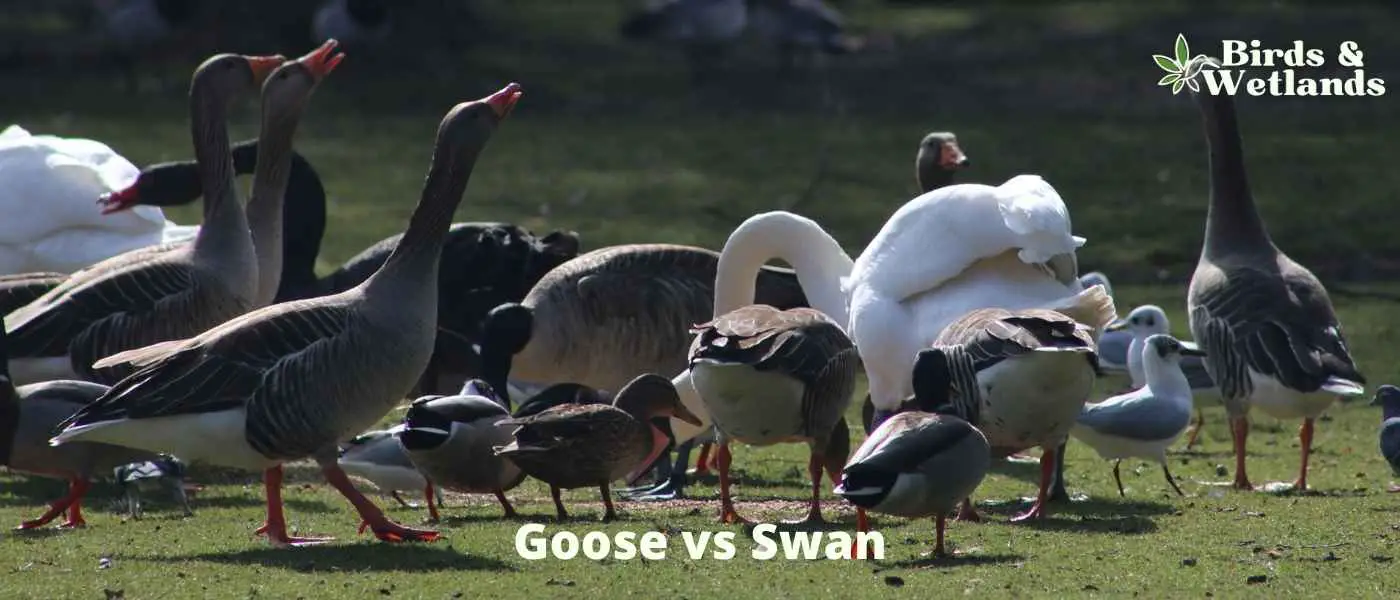There are many different types of waterfowls in the world, but two of the most well-known water birds are the swan and the goose. Though they share some similarities, there are still some significant differences between the two.
For example, a swan is much larger than a goose. Most swan species are white in color while geese have multi-colored plumage.
Do Geese and Swans Belong to the Same Family?
Yes, both the swan and goose belong to the Anatidae family. This family also includes ducks. All three types of birds are water birds, meaning they live near or on bodies of water.
Swans and geese are larger than ducks, and they have long necks. Swans also have a knob at the end of their bill.
Interestingly, the Coscoroba Swan lacks the characteristic knob on its beak found on most other species of swans. Unlike other swans which have bare skin extending from the bill to the eye, its feathers cover that area.
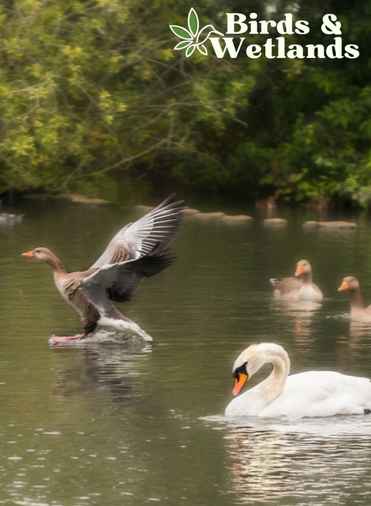
Swan Vs Goose: Quick Comparison
Swans
| Genus | Cygnus |
| Average Size | 4 to 5.2 ft |
| Average Weight | 20 to 30 lbs |
| Average Wingspan | 35 to 40 in |
| Average Lifespan | 10 to 12 years |
| Incubation | 35 to 41 days |
| Diet | Aquatic Vegetation |
| Domestication | No |
Goose
| Genus | Anser & Branta |
| Average Size | 2.5 to 3.6 ft |
| Average Weight | 5 to 14 lbs |
| Average Wingspan | 50 to 73 in |
| Average Lifespan | 10 to 15 years |
| Incubation | 28 to 30 days |
| Diet | Aquatic vegetation, grass, grains, and small insects |
| Domestication | Yes |
Swan vs Goose: Overview of Swans in North America
- Swans are a common sight in North America. There are different types of swans found on the continent – the trumpeter swan and the tundra swan.
- The trumpeter swan is the largest North American waterfowl and can be up to 5.2 feet long and weigh over 25 pounds. They are found in open wetlands and lakes in the northern US and Canada.
- The tundra swan is a bit smaller, measuring 4 to 5 feet long and weighing 15 to 20 pounds. They inhabit the Arctic tundra and are often seen migrating south in the winter.
- Most swans are white in color but other species have black feathers such as the black-necked swan and black swan.
- Both trumpeter and tundra swans are protected under the Migratory Bird Treaty Act, which makes it illegal to harm or kill them. If you see a swan in North America, enjoy the view but don’t get too close – these birds can be aggressive and may attack if they feel threatened.
- In the late 1800s, a third species, the Mute Swan, was brought to North America. In recent years, many people have come to think of it as an invasive species because its numbers are growing quickly and it affects other waterfowl and native ecosystems.
- Overwintering vagrant swans such as the Whooper swan have been sighted in northeastern North America and Alaska.
Swan vs Goose: Overview of Geese in North America
- The different several goose species in North America include the Canada goose, grey geese, black brant goose, snow goose, Ross’s goose, and white geese. Although not part of North America, Hawaii has a native goose species – the Hawaiian goose.
- Geese are a type of bird that can be found in North America. They live in areas where there is a lot of water, such as wetlands and rivers. Geese eat a variety of things, including grass, insects, and fish.
- Geese live in flocks and are social animals. They make a lot of noise, especially when they are taking off or landing. When geese mate, they stay together for life.
- Geese can be a nuisance to people because they often leave their droppings in public places. They also have a habit of chasing people and animals.
- Geese are hunted for their meat and feathers. The hunting of geese is regulated by the government in order to keep the population under control.
- Geese have longer legs despite being smaller in size.
Goose vs Swan: Characteristics and Appearance
Swans
Trumpeter Swans
The trumpeter swan is the largest waterfowl in North America. They have long necks and are mostly white with a black bill. They can be up to 5.2 feet long and weigh more than 25 pounds.
Trumpeter Swans are migratory and can be found in many parts of North America. They are known for their beautiful trumpeting call.

Tundra Swan
The tundra swan is a migratory bird that winters in North America. It has a long, slender neck and large wingspan. Tundra swans are gray or white in color, with a black bill, legs, and webbed feet. It feeds on aquatic plants and animals. When it migrates south, it nests in marshy areas.
Mute Swan
The mute swan is a large white bird that is found in North America. It has a long neck and a characteristic curved bill. The mute swans are infamous for their aggressive nature, and often attacks other birds and animals. It is a not vocal as other swan species, but it is not literally mute.

Geese
Canada Goose
The Canadian goose of North America is known for its brown and white feathers, and its black head and neck. They are approximately 2.5 to 3.6 feet in length and weigh between 5 to 14 pounds.
Canada geese are very social birds, and can often be seen in large flocks. They are excellent swimmers and are known to fly in V formation.
Black Geese
The black brant goose is a North American species of brant goose. It is small, with a body that is mostly black, with a white patch on the throat and belly. The face is also black as well as the bill.

Snow Goose
Snow geese are white in color, with black wingtips. They are migratory birds and can be found in North America and Europe. They typically weigh between 2 and 5 pounds and have a wingspan of up to 47 to 52 inches. Snow geese are omnivorous, feeding on both plants and animals. They usually nest near water sources, such as lakes or rivers.
Ross’s Goose
Ross’s goose is a medium-sized North American goose with a mostly white body, head and neck, and large pinkish bill.
Ross’s geese are migratory and can be found in both fresh and salt water. They are very vocal and can be heard honking from a long distance.
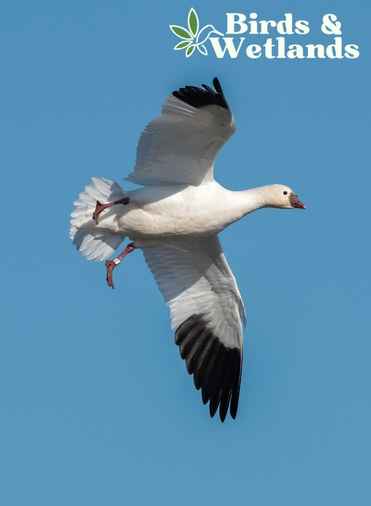
White-Fronted Goose
The white-fronted goose is a North American has a white face and a black bill. The body is gray or brown, with a pale underside. The wings are black and white, and the tail is black. The legs are pinkish or orange. These geese are migratory, and they breed in the Arctic tundra. They winter in southern Canada and the northern United States.
Goose vs Swan Differences
When it comes to goose vs swan differences, there are quite a few of them.
Tail Feathers
Geese and swans have different tail feathers. Swans’ tails are long, tapered, and all-white while geese’s tails are shorter and fatter with black tips on the feathers. These differences can help you tell which bird you’re looking at.
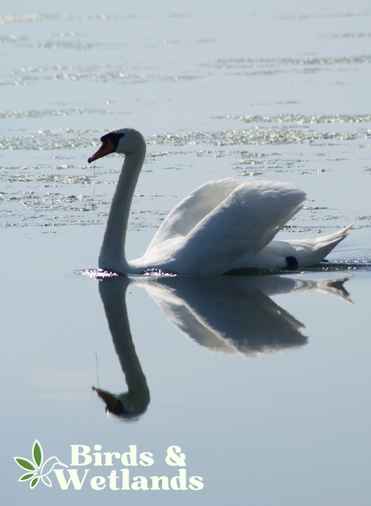
Bills
The bill of a swan is longer, more curved, and has a softer orange or pink color than the bill of a goose. Goose bills are black. The difference in bill shape is due to the different diets of the two birds. Swans eat aquatic plants, while geese eat mostly grasses and grains. The long, curved bill of the swan helps it to effectively collect and eat aquatic vegetation. The shorter, blunter bill of the goose is better suited for grazing on grasses and grains.
Size
There is a big difference between the size of swans and geese. Geese are much smaller than swans. Swans can be as big as three times the size of a goose.
Breeding Habits
Geese and swans are similar in many ways. Both geese and swans mate for life which means they are monogamous birds. But some swans have multiple mates over the course of their lifetime. Additionally, swan pairs don’t usually live together while geese couples do.
Geese start their nesting season earlier than swans. A female swan will lay about seven eggs while a female goose lays about two to six eggs.
Due to their monogamous nature, both parents help care for the young, goslings are typically raised by the mother goose while cygnets are raised by both parents.
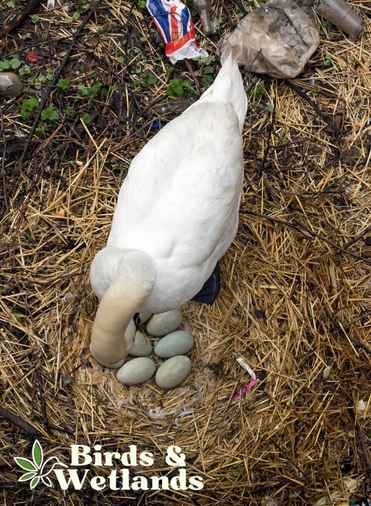
Behavior
Unlike swans, geese are more social and docile in most cases. But some swans such as the black swan can be social as well. However, this does not mean that swans are never aggressive.
For instance, the mute swans are considered among the most aggressive waterfowl bird species in the world. If a swan feels threatened during the breeding season, it may attack an aggressor by biting or striking with its powerful wings.
Most geese will become aggressive if they feel threatened or if you get too close to their territory. Similarly, swans will show a more aggressive nature, with the mated pair preferring to live with their mate and younglings.
It is important to be aware of the potential for aggression from both geese and swans. If you are in an area where these birds are present, be sure to give them plenty of space and do not approach their nests.
If a swan or goose does become aggressive, try to calm it down by speaking in a quiet, soothing voice. If this does not work, you may need to call animal control for assistance.
Habitat
Swans spend most of the time in the water to get away from their natural predators. And swans live in cold habitats and are mostly found in the northern hemisphere. But both swans and geese are water birds.
Despite their grace and elegance in the water, swans tend to be awkward on land. On the other hand, geese tend to blend their habitat between water and land, spending time on fields, prairies, tundra, forests, and even oceans as well as ponds and lakes.
Overall, however, both geese and swans need a place to swim and forage for food, so their habitats tend to have some similarities. Both birds also tend to migrate in search of better conditions, although swans generally only migrate short distances while geese may travel much farther.
Diet
Both swans and geese eat a variety of food including aquatic vegetation, small insects, and small fish. Geese browse for food on land more than in the water while swans browse for food in the water most of the time.
Conclusion on Goose vs Swan: Difference Between Swan and Goose
Swans and geese evolved from the same bird so it’s not surprising that some people mistake one for the other. Both the swan and geese are interesting breeds of birds with unique characteristics and traits. However, while a goose can be domesticated, it would be difficult to tame a swan at home. Adult swans are quite large and need plenty of space to live. They also require a lot of food in order to survive. They are best left in their natural habitat.

